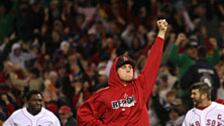Here we go again. The Boston Red Sox pulled off yet another miraculous comeback Thursday night, scoring eight times after they trailed the Tampa Bay Rays by seven runs with seven outs to go. These comebacks are becoming almost expected of the Sox, which is all the more remarkable considering that they were once legendary as a team that always found ways to lose in the end.
The Red Sox come from way, way behind to defeat the Devil Rays on Thursday night, 8-7
That started to change in 2004, of course, when they fought back to win the American League Championship Series (ALCS) against their hated rivals, the New York Yankees, after trailing three games to none. It was the first time in the whole long history of baseball that any team had won after trailing by 3-0 in a best-of-seven game series. Last season, the Sox pulled off almost as difficult a feat, coming back to defeat the Cleveland Indians in the ALCS after trailing three games to one.
The Red Sox return the favor in 2004 with an incredible come-from-behind win.
It is an amazing departure from form. Baseball fans—and especially Boston's own, enormously affected, self-obsessed fans, who have dubbed themselves "Red Sox Nation"—used to be able to recite from memory all the famous BoSox flops: the 1978 season, when they blew a 14-game lead over the Yankees; still the largest regular-season margin ever squandered by a team. The 1986 World Series debacle against the Mets when, one out away from a World Championship, they allowed three hits, a wild pitch, and the infamous Bill Buckner error. The 2003 ALCS finale in New York, when they blew a 5-2 lead in the eighth inning; even the last two games of the 1949 season when, needing just one to win the pennant, they lost both before a baying Yankee Stadium crowd.
The Yankees defeat the Red Sox in Game 7 of the 2003 ALCS
What can we conclude about all this? The nasty little suspicion might be that baseball teams are just passing collections of highly skilled athletes who have little to do with the men who once happened to play in the same jersey and on the same field. But this would be to debunk more than a century of superstition and lore that adamantly maintains that teams have fates and personalities—all the decades of Boston's "Curse of the Bambino," or the Chicago Cubs' "Curse of the Billy Goat"; the notion of the Yankees as the arrogant "evil empire," the Sox as plucky underdogs, the Cubs as lovable losers.
What really enables a great comeback? Destiny? Character? Well, often it requires a lot of help from the other side. Last night it was Tampa Bay manager Joe Maddon inexplicably failing to bring in his best lefty reliever to face Boston's David "Big Papi" Ortiz, a gargantuan individual with a long history of clutch hits. Big Papi put the ball in the right-field seats for a three-run homer and the comeback was on. In 2004, New York manager Joe Torre sat so passively in the dugout during the Red Sox comeback that many Yankee fans feared he had suffered a small stroke. In 2003, Boston manager Grady Little cost his team the game and himself a job by leaving Pedro Martinez out on the mound long after he was obviously gassed.
This is the thing about great comebacks: They're not supposed to happen. And thus as scintillating, as thrilling as they often are to watch, they also come tinged with tragedy for those who "blew it." Bill Buckner's long, outstanding career has been forever overshadowed by the hurried moment when he let a routine grounder go through his legs and helped cost the Red Sox the World Series.
Buckner seems to have handled the notoriety with admirable grace and poise. Two other victims of comebacks were not so fortunate. In 1986, the same year as Buckner's blunder, California Angels relief pitcher Donnie Moore let up a two-out, two-strike, bottom-of-the-ninth home run that ended up costing his team the pennant. Moore, always a highly troubled, violent individual, let the opprobrium overwhelm him and, a few years later, shot and badly wounded his wife, then killed himself.
This is the thing about great comebacks: They’re not supposed to happen. And thus as scintillating, as thrilling as they often are to watch, they also come tinged with tragedy for those who “blew it.”
The very best comeback in a single postseason game was in 1929, just days before another famous Wall Street crash. Joe McCarthy's Chicago Cubs held an 8-0 lead over one of Connie Mack's great Philadelphia Athletics teams. The Cubs trailed two games to one and seemed on the verge of tying the series. Then, also in the bottom of that unlucky seventh inning, the A's scored ten runs, taking control of the game and the series, which they won three days later—this time by scoring three runs in the bottom of the ninth.
The key was, once again, not so much the fortitude of the Athletics as the incompetence of the Cubs, in particular centerfielder Lewis Robert "Hack" Wilson. Wilson looked more like a bouncer at a waterfront bar than a ballplayer. He was only five-foot-six but weighed 195 pounds, with a hugely muscled upper body and sawed-off legs that ended in tiny feet. He wore a size 18 collar, size 6 shoes, and had a face like an undercard boxer at the end of bad night. For all that, he was a ferocious hitter, a Hall of Famer who still holds the single-season major league record for RBI in a season with 190.
Wilson was also a surprisingly good centerfielder, but not that day in Philadelphia. First he lost a fly by the Athletics' Bing Miller in the sun for a single. A few batters later, he lost track of another drive, this one by Mule Haas. It went over his head, and before Hack could retrieve it, Haas and two other players had circled the bases. Had Wilson caught both balls, the Cubs would have been out of the inning. Instead, their lead was cut to 8-7, and dissolved completely minutes later. What happened? Wilson was a notorious drunk, even among the hard-drinking ballplayers of his day, and rumors lingered that he was intoxicated or hungover that afternoon. That may well have been false—he had two hits on the day, and batted .471 for the series—but the rumors followed Wilson for the rest of his career. He had a couple more outstanding seasons but was out of the majors in five years, aged only 34. He never could overcome his love of the bottle and, despite an attempted comeback of his own managing one of the famous women's teams during World War II—he is the model for Tom Hanks' character in A League of Their Own—he was dead by the time he was 48.
Nothing so dire is likely to happen in the wake of last night's comeback, of course. But it speaks to why ballplayers tend to play with a level of equilibrium that often frustrates their more mystical, excitable fans. They know that it's more than a game, it's a profession, and character means keeping a level head even when everyone is talking about curses and destiny.





